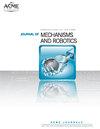基础驱动三菱形配置腰部穿刺远程运动中心机构的研制
IF 3.2
4区 计算机科学
Q2 ENGINEERING, MECHANICAL
Journal of Mechanisms and Robotics-Transactions of the Asme
Pub Date : 2023-06-19
DOI:10.1115/1.4062761
引用次数: 0
摘要
由于安全性和可重复性的优点,在腰椎穿刺(LP)过程中采用了远程运动中心(RCM)机制来引导插入角度和深度。然而,现有RCM机构中的近端致动模式在末端执行器附近占据了很大的空间,这阻碍了视野并增加了系统惯性。在这项工作中,首次提出了一种用于LP操作的底座驱动三菱形配置的RCM机构,其中为运动传动设计了对称的三菱形方案。因此,该机构的旋转和平移运动分别通过两个底座安装电机的同源和异源驱动来实现。建立了RCM机构的运动学模型,对其可操纵性、奇异性和工作空间进行了理论分析。提供了参数优化程序,以最大限度地减少RCM机构的占地面积。实验结果表明,该机构的插入角为-29.2°-29.2°,最大插入深度为60.02 mm,占地面积为4.98×104 mm2。RCM点的最大误差为1.1 mm。本文章由计算机程序翻译,如有差异,请以英文原文为准。
Development of a Base-Actuated Three-Rhombus Configured Remote Center Of Motion Mechanism for Lumbar Puncture
Owing to the advantages of safety and reproducibility, remote center of motion (RCM) mechanisms are adopted in lumbar puncture (LP) procedures to guide the insertion angle and depth. However, the proximal-actuated pattern in existing RCM mechanisms occupies large space near the end effector, which obstructs the visual field and increases the system inertia. In this work, a base-actuated three-rhombus configured RCM mechanism for the LP operation is firstly proposed, where the symmetric three-rhombus scheme is designed for the motion transmission. As a result, the rotational and translational motions of the mechanism are respectively realized through the homodromous and heterodromous actuations of the two base-mounted motors. Kinematic models are established to analyze the manipulability, singularity, and workspace of the RCM mechanism theoretically. Parameter optimization procedure is provided to minimize the footprint of the RCM mechanism. Experimental results show that the mechanism reaches an insertion angle from −29.2° to 29.2°, a maximum insertion depth of 60.02 mm, and a footprint of 4.98 × 104 mm2. The maximum error of the RCM point is 1.1 mm.
求助全文
通过发布文献求助,成功后即可免费获取论文全文。
去求助
来源期刊

Journal of Mechanisms and Robotics-Transactions of the Asme
ENGINEERING, MECHANICAL-ROBOTICS
CiteScore
5.60
自引率
15.40%
发文量
131
审稿时长
4.5 months
期刊介绍:
Fundamental theory, algorithms, design, manufacture, and experimental validation for mechanisms and robots; Theoretical and applied kinematics; Mechanism synthesis and design; Analysis and design of robot manipulators, hands and legs, soft robotics, compliant mechanisms, origami and folded robots, printed robots, and haptic devices; Novel fabrication; Actuation and control techniques for mechanisms and robotics; Bio-inspired approaches to mechanism and robot design; Mechanics and design of micro- and nano-scale devices.
 求助内容:
求助内容: 应助结果提醒方式:
应助结果提醒方式:


